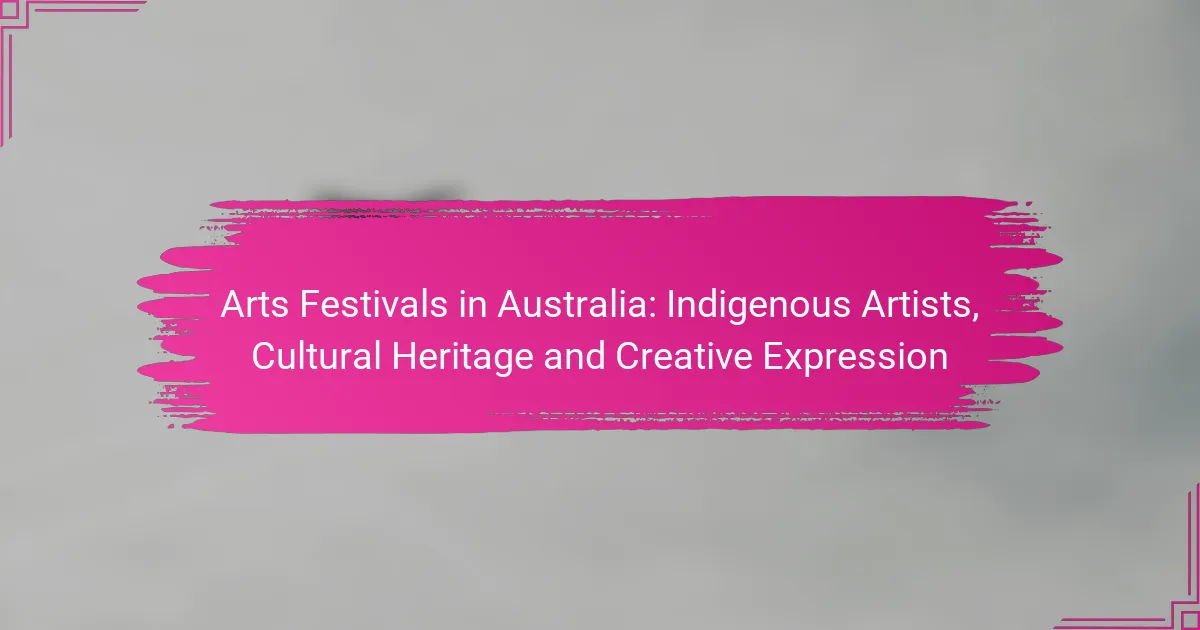Australia’s vibrant arts festivals serve as vital platforms for Indigenous artists, celebrating their rich cultural heritage and creative expression. These events not only showcase a blend of traditional and contemporary art forms but also foster community engagement and awareness, ensuring that unique narratives and cultural legacies are preserved and shared with broader audiences.
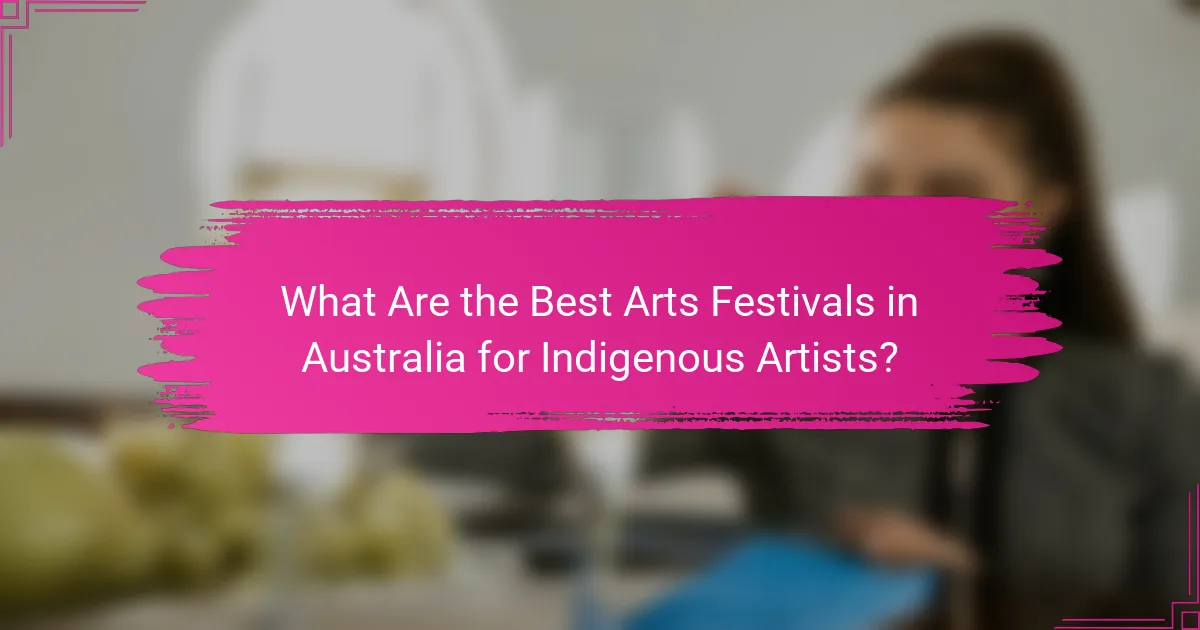
What Are the Best Arts Festivals in Australia for Indigenous Artists?
Australia hosts several prominent arts festivals that celebrate Indigenous artists and their cultural heritage. These festivals provide platforms for creative expression, showcasing traditional and contemporary art forms while fostering community engagement and awareness.
Yabun Festival
The Yabun Festival, held annually in Sydney, is one of the largest celebrations of Aboriginal and Torres Strait Islander cultures. It features a diverse lineup of performances, art exhibitions, and workshops, attracting thousands of attendees each year.
Visitors can experience traditional music, dance, and storytelling, alongside contemporary Indigenous art. The festival also includes stalls offering Indigenous food and crafts, making it a vibrant cultural experience.
Geraldton Indigenous Festival
The Geraldton Indigenous Festival takes place in Western Australia and highlights the rich cultural heritage of local Indigenous communities. This festival includes art displays, cultural performances, and interactive workshops designed to educate attendees about Indigenous traditions.
With a focus on community involvement, the festival encourages local artists to showcase their work, providing a platform for emerging talent. It often features traditional dance performances and storytelling sessions that engage audiences of all ages.
NAIDOC Week Celebrations
NAIDOC Week is celebrated across Australia, focusing on the history, culture, and achievements of Aboriginal and Torres Strait Islander peoples. Each year, various events are organized, including art exhibitions, community festivals, and educational activities.
During this week, many local councils and organizations host events that feature Indigenous artists and performers. It’s an opportunity for communities to come together and celebrate Indigenous culture through art, music, and dance.
Desert Harmony Festival
Located in the Northern Territory, the Desert Harmony Festival showcases the artistic talents of Indigenous artists alongside other cultural expressions. The festival includes music, dance, and visual arts, emphasizing the connection between art and the land.
Workshops and performances often highlight traditional practices, allowing attendees to engage directly with Indigenous culture. The festival fosters a sense of community and promotes understanding of Indigenous issues through creative expression.
Woodford Folk Festival
The Woodford Folk Festival, held in Queensland, is a multi-day event that features a wide range of artistic performances, including those by Indigenous artists. This festival celebrates diversity and creativity, with a strong emphasis on cultural exchange.
Indigenous performers often take center stage, showcasing traditional music and dance alongside contemporary works. The festival also offers workshops that allow participants to learn about Indigenous art forms and cultural practices, enriching the overall experience.
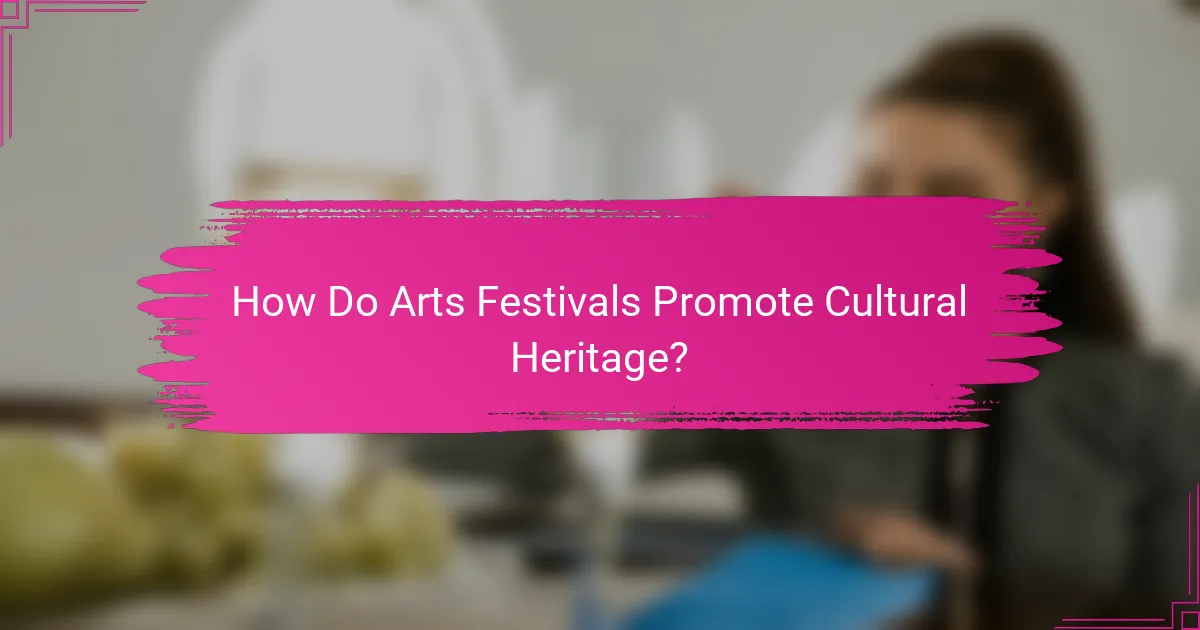
How Do Arts Festivals Promote Cultural Heritage?
Arts festivals play a crucial role in promoting cultural heritage by providing a platform for diverse artistic expressions, particularly from Indigenous artists. These events celebrate traditional practices, highlight unique narratives, and foster community engagement, ensuring that cultural legacies are preserved and shared with wider audiences.
Showcasing Traditional Practices
Arts festivals often feature performances, workshops, and exhibitions that showcase traditional practices, such as dance, music, and visual arts. These activities allow artists to demonstrate their skills and the cultural significance behind their work, helping attendees appreciate the depth of Indigenous heritage.
For example, festivals may include traditional weaving demonstrations or storytelling sessions that convey historical and cultural narratives. Such showcases not only educate the public but also empower Indigenous artists by providing them with a platform to share their knowledge and artistry.
Highlighting Indigenous Narratives
Through various forms of art, festivals highlight Indigenous narratives that reflect the community’s history, struggles, and triumphs. This storytelling aspect is vital for fostering understanding and respect among diverse audiences.
Events often feature films, literature readings, and visual art that delve into themes of identity, connection to land, and cultural resilience. By amplifying these narratives, arts festivals contribute to a broader recognition of Indigenous perspectives and experiences.
Encouraging Community Participation
Community participation is a cornerstone of arts festivals, as they invite local residents to engage with the arts and cultural heritage actively. This involvement can take many forms, from volunteering to attending workshops and performances.
Festivals often organize collaborative projects that encourage participants to create art together, fostering a sense of belonging and shared identity. Additionally, these events can serve as a catalyst for ongoing cultural activities within the community, strengthening ties and promoting cultural continuity.
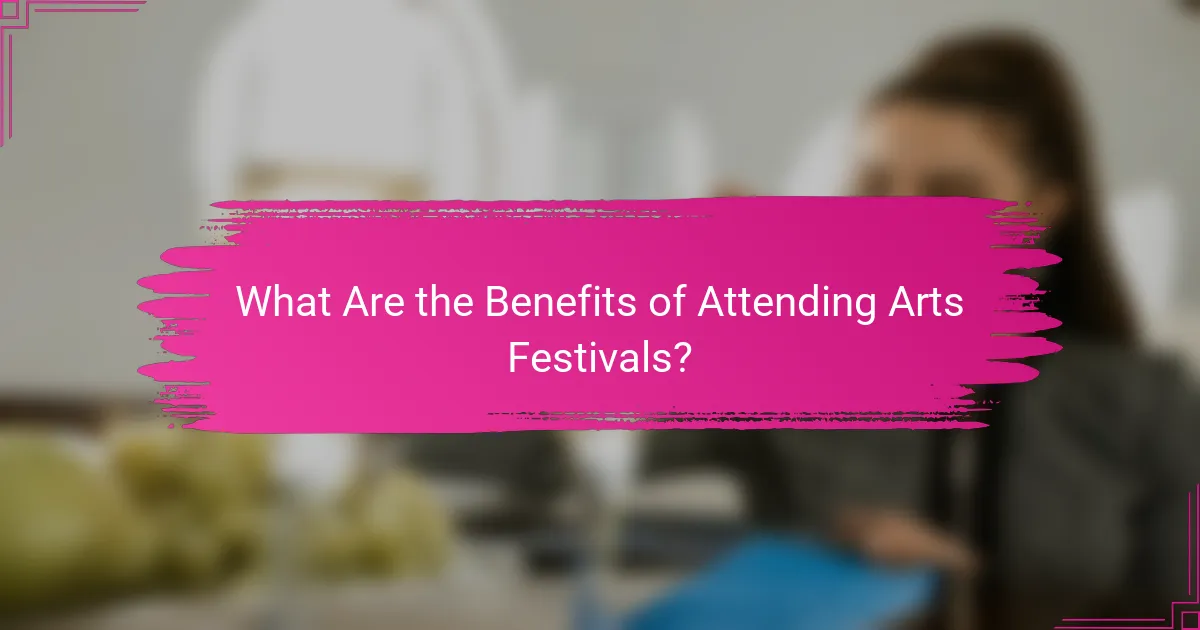
What Are the Benefits of Attending Arts Festivals?
Attending arts festivals offers numerous benefits, including exposure to various art forms, support for local and Indigenous artists, and valuable networking opportunities. These events foster cultural appreciation and community engagement, making them essential for both artists and attendees.
Exposure to Diverse Art Forms
Arts festivals showcase a wide range of artistic expressions, from visual arts to performance and multimedia installations. This diversity allows attendees to experience different cultural perspectives and artistic techniques, enriching their understanding of creativity. For example, festivals may feature traditional Aboriginal art alongside contemporary installations, highlighting the evolution of artistic practices.
Support for Indigenous Artists
Many arts festivals in Australia prioritize the inclusion of Indigenous artists, providing them with a platform to share their cultural heritage and creative expressions. This support not only helps preserve Indigenous art forms but also promotes awareness and appreciation among broader audiences. By attending these festivals, visitors contribute to the economic sustainability of Indigenous communities and help elevate their voices in the arts.
Networking Opportunities
Arts festivals create an environment conducive to networking among artists, curators, and art enthusiasts. Attendees can connect with industry professionals, exchange ideas, and collaborate on future projects. Participating in workshops or panel discussions often leads to meaningful relationships that can enhance an artist’s career or inspire new creative endeavors.
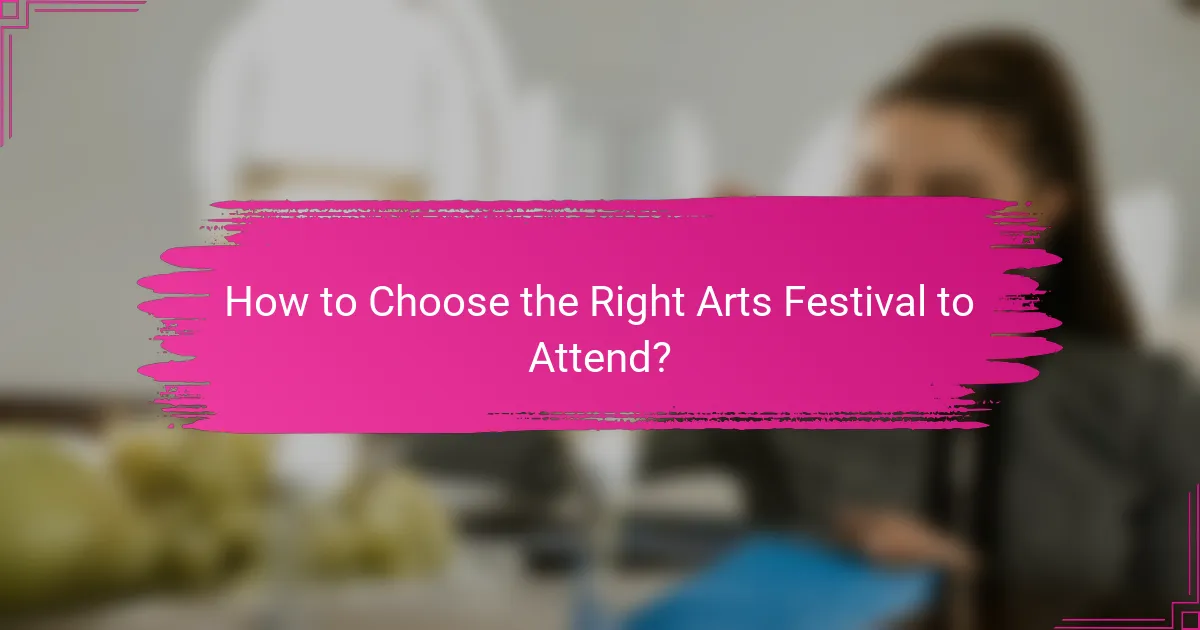
How to Choose the Right Arts Festival to Attend?
Choosing the right arts festival involves considering factors like location, themes, and available activities. By evaluating these elements, you can ensure a fulfilling experience that aligns with your interests and accessibility needs.
Consider Location and Accessibility
Location plays a crucial role in selecting an arts festival. Consider how far you are willing to travel and whether the festival is in a city or a rural area. Accessibility to public transport and parking facilities can significantly impact your experience.
Check if the festival venue is accessible for individuals with disabilities. Many festivals in Australia strive to be inclusive, but it’s wise to verify specific accommodations in advance.
Evaluate Festival Themes and Focus
Different arts festivals may focus on various themes, such as Indigenous culture, visual arts, or performing arts. Look for festivals that resonate with your interests, as this will enhance your engagement and enjoyment.
Some festivals may highlight local Indigenous artists and cultural heritage, offering unique insights into Australia’s diverse artistic landscape. Research the festival’s program to understand its focus and featured artists.
Check for Workshops and Activities
Many arts festivals offer workshops and interactive activities alongside exhibitions. Participating in these can deepen your understanding and appreciation of the art forms presented.
Look for festivals that provide hands-on experiences, such as art-making sessions or discussions with artists. This can be a great way to connect with the community and enhance your festival experience.
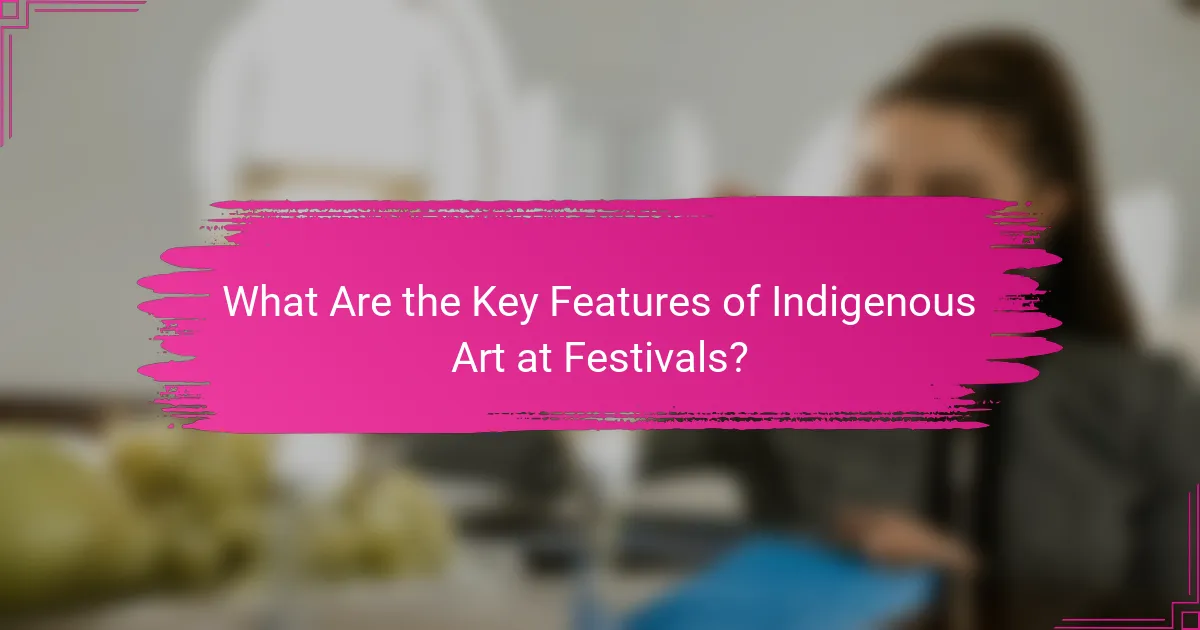
What Are the Key Features of Indigenous Art at Festivals?
Indigenous art at festivals showcases the rich cultural heritage and creative expression of Aboriginal and Torres Strait Islander peoples. Key features include traditional techniques, storytelling elements, and collaborative projects that highlight community and identity.
Traditional Art Techniques
Traditional art techniques used by Indigenous artists often include dot painting, bark painting, weaving, and carving. These methods are deeply rooted in cultural practices and are passed down through generations, reflecting the artists’ connection to their land and ancestors.
Artists frequently utilize natural materials such as ochres, clay, and plant fibers, which not only enhance the authenticity of their work but also promote sustainable practices. Festivals provide a platform for artists to demonstrate these techniques, allowing audiences to appreciate the skill and cultural significance behind each piece.
Storytelling Through Art
Storytelling is a fundamental aspect of Indigenous art, where each artwork conveys narratives about the land, spirituality, and community. Artists often incorporate symbols and motifs that represent their cultural stories, making each piece a visual representation of their heritage.
During festivals, artists may share the stories behind their works, fostering a deeper understanding and appreciation among viewers. This interactive element encourages dialogue and connection, enriching the festival experience for both artists and attendees.
Collaborative Art Projects
Collaborative art projects are common at Indigenous festivals, where artists come together to create large-scale installations or community artworks. These projects not only showcase individual talents but also emphasize the importance of community and collective identity.
Such collaborations often involve workshops and participation from festival-goers, allowing them to engage directly with the art-making process. This hands-on approach helps to break down barriers and fosters a sense of unity and shared cultural pride among participants.
